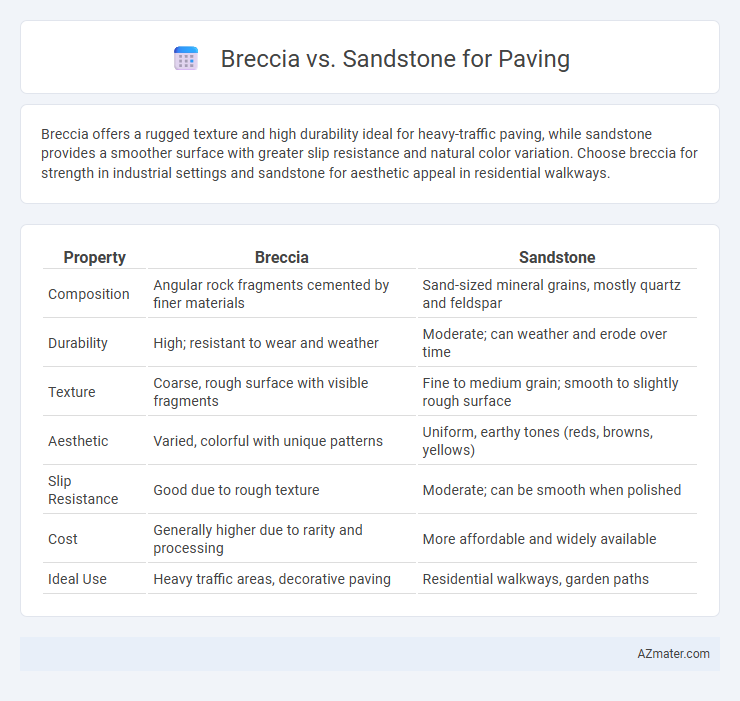Breccia offers a rugged texture and high durability ideal for heavy-traffic paving, while sandstone provides a smoother surface with greater slip resistance and natural color variation. Choose breccia for strength in industrial settings and sandstone for aesthetic appeal in residential walkways.
Table of Comparison
| Property | Breccia | Sandstone |
|---|---|---|
| Composition | Angular rock fragments cemented by finer materials | Sand-sized mineral grains, mostly quartz and feldspar |
| Durability | High; resistant to wear and weather | Moderate; can weather and erode over time |
| Texture | Coarse, rough surface with visible fragments | Fine to medium grain; smooth to slightly rough surface |
| Aesthetic | Varied, colorful with unique patterns | Uniform, earthy tones (reds, browns, yellows) |
| Slip Resistance | Good due to rough texture | Moderate; can be smooth when polished |
| Cost | Generally higher due to rarity and processing | More affordable and widely available |
| Ideal Use | Heavy traffic areas, decorative paving | Residential walkways, garden paths |
Introduction to Breccia and Sandstone
Breccia is a sedimentary rock composed of angular fragments cemented together, known for its unique texture and durability in paving applications. Sandstone consists of compacted sand-sized mineral particles, offering a smoother surface that is both aesthetically pleasing and slip-resistant. Both materials provide distinct benefits for paving, with breccia delivering rugged strength and sandstone offering natural beauty.
Geological Formation of Breccia and Sandstone
Breccia forms through the rapid cementation of angular rock fragments typically produced by mechanical weathering or tectonic activity, resulting in a coarse, irregular texture ideal for rugged paving surfaces. Sandstone develops from the compaction and cementation of sand-sized mineral particles, usually quartz, deposited in sedimentary environments such as rivers, beaches, or deserts, offering a smoother texture and uniform durability. The geological formation processes influence their respective porosity and hardness, making breccia more fracture-resistant but less uniform compared to the more homogenous, weather-resistant sandstone suited for decorative paving.
Physical Properties Comparison
Breccia features angular, coarse-grained fragments bound by a fine matrix, resulting in high compressive strength and excellent durability for paving applications. Sandstone consists of more uniform, rounded grains, providing moderate hardness and porosity, which affects its wear resistance and slip resistance under foot traffic. Breccia's lower porosity and higher fracture toughness make it more resistant to weathering and mechanical stresses compared to the more permeable and softer sandstone.
Aesthetic Appeal and Color Variations
Breccia offers a visually striking aesthetic with its angular fragments and natural, earthy tones ranging from deep reds to soft grays, creating a textured and dynamic paving surface. Sandstone provides a smoother, more uniform appearance with a broad spectrum of warm colors including tans, golds, and pinks, enhancing spaces with a classic and timeless elegance. Both materials excel in color variation, but breccia's unique, fragmented patterns deliver a bold statement, while sandstone's consistent hues promote a subtle, harmonious look.
Durability and Longevity
Breccia offers superior durability for paving due to its angular, interlocking fragments that provide enhanced structural strength compared to the rounded grains of sandstone. Its resistance to weathering and abrasion makes breccia an ideal choice for high-traffic areas, ensuring long-lasting performance. Sandstone, while aesthetically pleasing, tends to be softer and more porous, requiring more frequent maintenance and exhibiting shorter longevity in harsh environments.
Slip Resistance and Safety Considerations
Breccia offers superior slip resistance compared to sandstone due to its rougher, angular texture, making it a safer choice for paving in wet or high-traffic areas. Sandstone has a smoother surface that can become slippery when wet, posing potential safety risks, especially in outdoor environments exposed to rain or moisture. Careful selection based on slip resistance ratings and application context is essential to ensure optimal safety in paved surfaces.
Installation Process and Maintenance
Breccia and sandstone differ significantly in their installation and maintenance for paving applications. Breccia, a denser and more brittle natural stone, requires careful cutting and anchoring during installation to prevent cracking, while sandstone's softer, porous nature allows easier cutting but necessitates stabilization with sealing agents. Maintenance involves regular sealing for sandstone to prevent water absorption and staining, whereas breccia demands less frequent sealing but periodic inspection for surface chips or fractures.
Environmental Impact and Sustainability
Breccia offers a low-impact option for paving due to its local quarry sourcing, minimizing transportation emissions and preserving natural resources by using irregular rock fragments bonded naturally. Sandstone, while widely used, often requires more intensive quarrying and processing, which can increase energy consumption and environmental degradation. Both materials have potential for sustainable use when sourced responsibly and combined with eco-friendly installation practices.
Cost Analysis and Budget Considerations
Breccia offers a unique, angular texture that typically commands a higher price point due to its quarrying and processing complexities compared to sandstone, which is generally more abundant and affordable for paving projects. Sandstone's lower cost makes it a preferred choice for large-scale or budget-sensitive applications, while breccia's premium aesthetics and durability can justify the investment for high-end landscaping and architectural features. Budget considerations must also account for long-term maintenance, with sandstone requiring more frequent sealing and repairs, potentially increasing total lifecycle costs relative to the more resilient breccia.
Best Applications for Paving: Breccia vs Sandstone
Breccia, characterized by its angular fragments cemented in a fine matrix, offers exceptional durability and slip resistance, making it ideal for high-traffic outdoor paving and driveways. Sandstone's natural porosity and softer texture provide a warmer aesthetic and comfortable walking surface, perfectly suited for patios, garden paths, and decorative landscaping. For paving projects requiring robustness and a rugged appearance, breccia stands out, whereas sandstone excels in applications demanding subtle elegance and ease of maintenance.

Infographic: Breccia vs Sandstone for Paving
 azmater.com
azmater.com